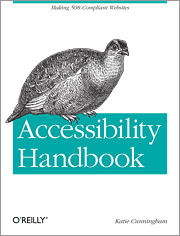review: Accessibility Handbook
¶ by Rob Friesel Katie Cunningham’s The Accessibility Handbook (O’Reilly, 2012) is a concise and specific introduction to accessibility (a11y) and 508-compliance. Cunningham provides a “walking tour” of the major types of disabilities that web developers need to consider when creating a site for a11y, illustrating how people with those disabilities will use a site, and then detailing easy solutions and best practices to craft a site with the necessary accommodations. Better yet, she makes strong cases for why many of these accommodations are actually “features” and not “compromises”.
Katie Cunningham’s The Accessibility Handbook (O’Reilly, 2012) is a concise and specific introduction to accessibility (a11y) and 508-compliance. Cunningham provides a “walking tour” of the major types of disabilities that web developers need to consider when creating a site for a11y, illustrating how people with those disabilities will use a site, and then detailing easy solutions and best practices to craft a site with the necessary accommodations. Better yet, she makes strong cases for why many of these accommodations are actually “features” and not “compromises”.
The book is broken into chapters such that each one focuses on a specific disability. Some of these disabilities may seem obvious (e.g., blindness, deafness), while others may come as a surprise (e.g., color blindess, motion disorders). Having the book sectioned in this way was a smart choice, as it becomes easy to focus on that one type of disability, and to reason about the strategies necessary for accommodating it. The goal of each chapter is to get you (as a developer) into a headspace where you can easily understand how a person with one of those disabilities will approach your site, thus making it easier for you to understand the 508-compliance rules.
As a front-end developer without much experience in the realm of a11y, and with no knowledge of 508-compliance, I approached this book as a good place to start. Having finished it, I maintain that it was a good introduction to the subject. Though I got the information about the disabilities and how to accommodate them, there was almost nothing in here about WAI-ARIA; granted: Cunningham cites ARIA, and shows some examples when talking about “Complete Blindness”, but she also says that it’s too big of a subject to cover in her book. That being said, when I find a good resource on ARIA, I’ll be pleased to know that this book gave me a decent framework for thinking about those problems.
Lastly, as I mentioned before, Cunningham does a decent job of explaining why many of the accommodations that she describes actually become “features” of your site, and not “compromises”. For example: everyone can benefit from having good tabindex properties set on your form fields. For example: everyone benefits from well-labeled graphs and charts. For example: by making your menus, icons, and other click-targets “adequately sized”, you’re not only helping someone with Parkinsons, you’re also helping people accessing your site from a mobile device. And lastly, my favorite example: by paying attention to the source order of the elements in your site, you’re not only helping the blind (and/or anyone else using a screen reader) but you’re also making it easier to give your site a responsive design (and I hear it’s helpful for SEO, as well).
Would I recommend this book? Yes, to someone who needs a quick “walking tour” of a11y–but probably not to someone who is already familiar with the subject, and definitely not to someone who is looking for more on WAI-ARIA.
Disclosure: I received an electronic copy of this book from the publisher in exchange for writing this review.
Leave a Reply